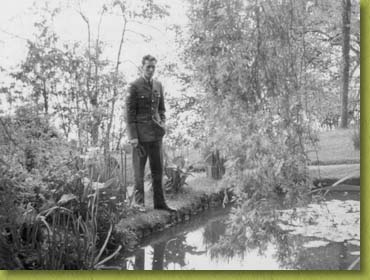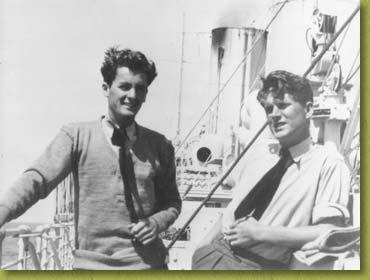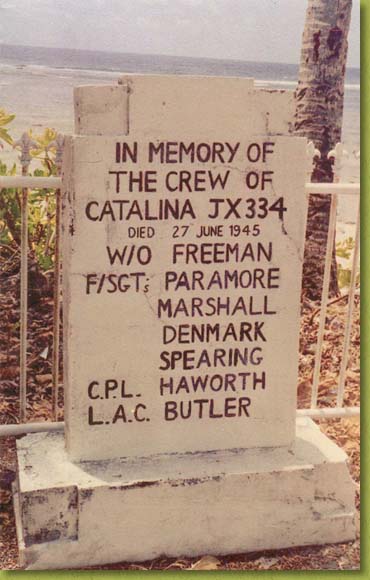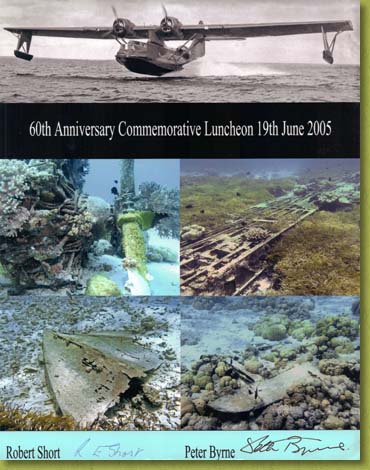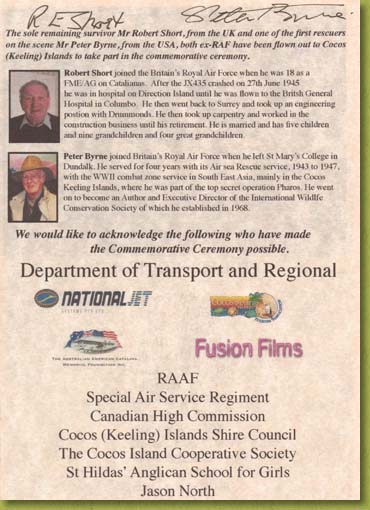 |
 |
|
 |
|
 |
|
 |
|
 |
|
 |
|
 |
|
 |
 |
||||||||||||||||||||||
|
In 1943, Peter, at the age of eighteen and after four years in a private school, St. Mary's College, Dundalk, Ireland, joined the British Royal Air Force. Being Irish, he was not subject to the British wartime draft and so volunteered. The RAF division that he chose was its Air Sea Rescue service (ASR) and he was immediately drafted to a seaplane base at Invergordon, Scotland, where he received two-fold training, as aircrew on Catalina and Sunderland long-range, reconnaissance seaplanes and as a marine pilot on Hants & Dorsett, armed, high-speed rescue boats. His training completed, he volunteered for SEAC-South East Asia Command-under the British supreme commander for Allied forces in Asia, Lord Louis Mountbatten and within a few weeks received a posting to India.
From Southampton, as part of a 45 man ASR unit, he was shipped to Bombay, India, going out by sea on the 25,000 ton Queen of Bermuda, a converted peacetime cruise liner. From Bombay, within days, he found himself, with his unit, on board a 5000 ton tramp steamer, the S.S. Salween, on the way to the Cocos Keeling Islands, which lie about half way between Colombo, Ceylon and Perth, Australia. There, in a set of coral atolls deep in the dark blue wastes of the Indian Ocean, he was immediately enrolled in the top secret OPERATION PHAROS, the RAF's contribution to the massive Allied, strategic force being assembled for the invasion of Japan. Peter spent fourteen months with his unit in the islands, based on a tiny islet in the seventeen island Cocos chain called Direction Island-half a mile long and three feet above sea level-and during this time took part in the rescue, by sea and by air, of twelve airmen, (two of them Australians) all of them from aircraft that had either accidentally crashed due to engine malfunction or weather, or were shot down by the Axis enemy, the Japanese. The most memorable of the rescues in which he was involved occurred in the Cocos Islands lagoon, when, on 27th June, 1945, a Catalina, JX435, flying from Red Hills Lake Air Force base at Madras, India, with fourteen men on board, crashed on landing and caught fire. Peter and another airman, Jim Whiting, of London, England, had shore duty that day and were standing by with a motor launch to go out and bring in the crew. Seeing the Catalina smash into the surface of the lagoon, in a spectacular explosion of white spray, they immediately jumped in their boat and went racing to the scene. Arriving at the stricken aircraft, already on fire, burning and sinking fast, they quickly moored their boat at one of the fuselage gun blisters and then climbed inside, through the hatch, and began carrying men out. As thick black smoke billowed from the front of the aircraft and the ruptured fuel tanks of the wings, slowly forcing them back, they lifted two very badly burned men and carried them to their boat and then assisted five more, all with injuries, out of the sinking seaplane. Then, within minutes, and before they could get anyone else out, the aircraft went down, taking with it seven men, all of them either dead or too injured to escape. After a quick circuit of the boiling hydraulics of the submerging aircraft, to see if anyone else was in the water, they raced back to the Direction Island jetty, where medics and stretcher bearers were waiting to take the injured men to the island's tiny dispensary. Of the seven men Peter and his companion Jim rescued, two died that night of their dreadful burns. Five survived and eventually returned to England, among them one Peter Collett, with whom Peter and Jim stayed in touch for many years. After the war, the islands, formerly owned by a Scottish group-the Clunies Ross family, who were in the copra trade-were purchased by the Australian government and soon after became a base for the Australian Air Force. In 2004, sixty years after the Catalina crash, Australian divers found the remains of the Catalina in the Cocos lagoon and the Australian government decided that some recognition should be given to the people who took part in the rescue, as well as any of the survivors who could be located. They invited Peter to the islands for commerative ceremonies and in 2005 he and his partner, Cathy Griffin, of Georgia, flew to Perth, and then out to the islands, as honored guests of the Australian government. There they were joined by the sole remaining survivor of the crash, Robert Short, from the UK. Peter and Cathy spent a week in the islands during which memorial ceremonies were carried out, the final one being the laying of floral wreathes on the surface of the crystal clear waters of the lagoon, under which some of the Catalina's fuselage, including its two huge engines, still lay on the bottom. Peter spent four years in the RAF, with all of his remaining time in India, and was demobilized in 1947, with four campaign medals and an honorable discharge. He promptly joined a British tea company, of colonial origins, in north India, which story will lead us to the next chapter of his very unique website. Peter Collett returned to England after the war and there enjoyed a long and meaningful life as a school teacher. He died in 2009. Jim Whiting, with whom Peter regularly corresponds, joined BOAC immediately after the war and now, after a long and interesting career with Britain's premier airline, and an enjoyable family life-and with his own son a pilot for BAC-lives is a retirement home in Solihull, in central England. Robert Short also returned to England and had an equally good life; he married and had four children. He died recently, in May, 2010. The two Catalina crew who died of their injuries the night after being brought ashore, Flight Sergeant Geoffrey Sims and Flight Sergeant Edward Benn, were buried by Peter's unit on Direction Island. Later their bodies were recovered and transferred to Kranji Cemetery, Singapore. The bodies of the seven other crew members, who went down with the aircraft, were never recovered. The site of the crash is now protected under Australian law and has been designated a Commonwealth Marine Area under the Environmental Protection and Biodiversity Act of 1999. |
|
|||||||||||||||||||||
|
Website Designed and Hosted by D INTERNET Solutions |
||||||||||||||||||||||
